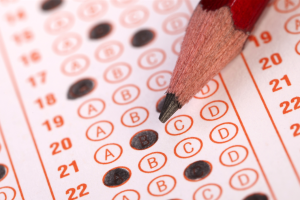Author’s Note: The authors, both high school teachers, are basing their writing primarily on personal experiences and research regarding the standardized test (steam)rolled out this year in their district, the SBAC.
Few things please parents more than learning that their children are invigorated about and engaged in their education, perhaps deconstructing the representation of women through a media literacy unit or trying Columbus for possible crimes against humanity – activities that represent education at its best.
Unfortunately, however, too many students are coming home from school deflated, defeated, and disillusioned.
Why?
The high-stakes testing season is in full swing.
What are high-stakes tests? Tests are considered high-stakes when they are tied to major consequences, such as graduation.
But this year’s season is anything but business as usual. Instead, we are experiencing the largest revolt against high-stakes testing ever, as historic numbers of families from New York to Seattle opt their children out, refusing to subject them to what is too often education at its worst.
The revolt has even recruited Last Week Tonight’s John Oliver, who let loose an 18-minute barrage against standardized testing.
Why are so many people are opting out?
1. High-Stakes Test Scores Correlate More with Socioeconomic Status Than Student Learning
As teachers, it’s a tough truth to swallow that our brilliant teaching isn’t the primary driver of our students’ test scores.
In reality, a far bigger predictor of student success is socioeconomic status – and guess who’s most likely to fail high-stakes tests.
Low-income students, of course.
And which students are overrepresented in the ranks of the poor? Students of Color, Special Education Students, English Language Learners, to name a few – all of whom the public education system has historically underserved, a euphemism for shittily served.
Courtesy of taxpayers’ dollars, these students now have a new hurdle.
In Washington and 27 other states, this new obstacle has one of two names: The Smarter Balanced Assessment Consortium exam (SBAC) and Partnership for Assessment of Readiblah Blah College Blah (PAARC), both of which tie passing to high school graduation. The SBAC markets its test as a tool to “improve instruction and help students succeed.”
More likely, it will serve as a sifter to sort primarily Brown and Black students directly into the school-to-prison pipeline.
After all, students pushed out of the public schools, inaccurately called “drop-outs,” are far more likely to end up incarcerated. (This result is not so surprising if you dig into the history of standardized testing, which is linked to the eugenics movement.)
In fact, one recent study showed that students who fail exams linked to graduation are 12.5% more likely to be incarcerated.
Maybe your child does not the fit the profile for such sifting and will unlikely land in jail. Maybe your bank account indicates that your child is destined to wear a high-test score with pride.
Unfortunately, in allowing that outfit, you are colluding with a system that perpetuates inequality, inequality that comes color-coded.
2. High-Stakes Tests Hijack and Derail Student Learning
Color-coded sifting begins early, when children should be learning through play, not multiple-choice bubbles. But in the world of high-stakes testing, play becomes a privilege denied to many Black and Brown children.
Schools are increasingly cutting recess time, not to mention lunch time and arts opportunities, for such students and replacing it with test-prep and testing – even though research tells us that recess actually helps academics.
And though the SBAC website has a whole page devoted to supporting “under-represented students,” many low-income students who rely on their computer lab or library for computer access are denied entry because the spaces are reserved for testing, ultimately increasing inequities.
In contrast, students in the advanced tracked classes – overwhelmingly White and wealthy – sometimes have the (White) privilege to skip entirely standardized tests (though not high-stakes ones) that fill up the computer lab’s schedule for weeks of the standard 180-day school year.
But even if you and your child are the ones reaping the benefits of an education system in which Black and Brown people are systematically fucked over based on multiple measures – push-out rates, overrepresentation in discipline, underrepresentation in advanced classes – it’s still in your own self interest to understand the proliferation of testing.
In More Than a Score, teacher and author Jesse Hagopian cites a 2013 study revealing that in 2013, students spent up to 50 hours each year taking standardized tests. Testing gobbles up so much class time that Florida passed a law capping the amount of standardized testing at 45 hours. Phew.
As a parent, you might prefer that your child spend that time actually learning – especially when you dig deeper into the reliability of these tests.
3. High-Stakes Tests Lack Proven Validity
According to the Huffington Post, at least one state’s education department has openly confirmed that “the tests administered in the state have not been demonstrated to be either reliable or valid.”
Other experts have reached this same conclusion.
Nevertheless, Washington State is currently demanding that tens of thousands of juniors take the SBAC, even though it won’t affect their graduation in its inaugural year (turning the high-stakes test, for many, into an expensive no-stakes waste of time).
Beginning with Nathan Hale High School – at which 100% of juniors refused the test – students across Seattle are revolting.
At other Seattle schools, it isn’t a revolt. It’s a “meltdown.”
Teachers across the district – who the Seattle superintendent has threatened with harsh discipline if they fail to administer the SBAC – report struggles logging in, finding translations for English Language Learners, and even administering the correct test.
Furthermore, the test clearly calls for some serious computer literacy – requiring students to “navigate confusing split screens; drag, drop, and highlight; and type extended responses” – setting up those with less computer access for failure.
So much for supporting “underrepresented students.”
4. High-Stakes Testing Allows for the Misuse of Test Scores
States and districts increasingly use testing to evaluate teachers, a methodology based on questionable research at best (and leading to the Atlanta cheating “scandal,” which Jon Stewart finds remarkably similar to Wall Street’s financial meltdown of 2008 – except the wealthy of Wall Street faced no jail time).
The students who will take this year’s tests are a completely different group from those who will take it next year. Thus, one year the test scores might indicate a teacher is “highly effective,” and the next year, a new group of students’ scores might indicate a struggling teacher.
Did such a teacher suddenly lose skills over one year? Of course not.
Edward Haertel of Stanford University says using tests scores to evaluate teachers is “sorting mostly on noise” because of the tests’ unreliability and inconsistency.
Because low-test scores track with poverty rates, teachers of poor students and students of Color are more likely to be rated ineffective and forced out. As a result, their students’ educations will be disrupted by a revolving door that deposits inexperienced teachers in their classrooms yearly.
Thus, high-stakes testing encourages interruption and disruption for the very same students who need continuity and stability the most.
The education “reform” movement pushes the business model that shutters those schools deemed ineffective based on low-test scores, schools filled with Black and Brown children. (And failure is the goal. Not one state met the goals set by No Child Left Behind, George W. Bush’s stab at education “reform.”)
And who benefits from the closure of these neighborhood fixtures? Charter schools run by private organizations, both for-profit and non-profit.
These charter schools can exempt themselves from employing mostly unionized labor with decent pay and job protections. In fact, only about 12% of charter schools are unionized.
Worse yet, studies show charter schools seldom outperform traditional public schools. In 2009, Stanford University’s Center for Research on Education Outcomes (CREDO) found that only 17% of charters outperformed traditional schools, while 37% performed worse.
Poor test scores, therefore, become tools to bust unions, to close schools that anchor neighborhoods, and to use public money often for private gain but with no gain in student learning.
But don’t take our word for it. Just ask former Assistant Secretary of Education, Diane Ravitch, who argues that the high-stakes testing movement is designed for exactly those very purposes.
And, again, even if your child is not attending a school likely to be closed, your taxpayer dollars are still supporting this movement.
5. High-Stakes Testing Squanders Millions
The price tag for these tests that have proven to be so damaging is about the only thing decadent about public education.
SBAC pegs the cost of each test at $27.30 per student, a seemingly low price. This low number looks a little different when you consider that last year in Washington State there were about 82,500 10th graders.
That’s a price tag of $2,252,250 – for just one grade. These tests are also slated for all students in grades 3-8 in states that have signed on to them.
Even SBAC itself cautions relying on its per test estimate. After all, that number doesn’t include key costs, such as tech support, test-coordinators, school counselors, and librarians, many of whom must now direct their times and energy to testing instead of student learning.
Could you think of anywhere that $2.2 million could be better spent? More field trips to connect students with their communities. Expanded arts experiences. More counseling services.
Any other ideas?
It’s unlikely you’ll answer that question with “A new test!”
***
We all recognize that $2.2 million is a great deal of money. To the corporate “education” “reformers” who are driving high-stakes testing, such an amount is loose change.
People like Bill Gates have spent millions and millions to promote the standards on which these tests are based. (For compelling critiques of the these standards, click here and here.)
These individuals are the very same ones pushing for charter schools. Right under our noses, a handful of wealthy elite is trying to put public education on the market.
It’s up to you if you are going to let them.
As teacher Jesse Hagopian has pointed out, the same wealthy elite who orchestrate the proliferation of high-stakes testing have opted out their own children by sending them to private schools, which never have to waste time on state standards and high-stakes tests.
Instead, these expensive private schools have the privilege to create meaningful and authentic assessments. Such assessments don’t need to be limited to the elite, however. Some of these have been developed by the public, high-achieving New York Performance Standards Consortium, which has been waiving standardized tests since 1997.
These are the assessments we all should demand. These are the assessments all children deserve.
There’s a revolution afoot. Which side are you on?
[do_widget id=”text-101″]
Jon Greenberg is a Contributing Writer for Everyday Feminism. He is an award-winning public high school teacher in Seattle who has gained broader recognition for standing up for racial dialogue in the classroom — with widespread support from community — while a school district attempted to stifle it. To learn more about Jon Greenberg and the Race Curriculum Controversy, visit his website, citizenshipandsocialjustice.com. You can also follow him on Facebook, Tumblr, and Twitter @citizenshipsj.
Gerardine Carroll, a National Board Certified Teacher, has 26 years of experience in both Catholic and public schools. In addition, she served as an adjunct instructor for six years in the School of Education at Seattle University.
Search our 3000+ articles!
Read our articles about:
Our online racial justice training
Used by hundreds of universities, non-profits, and businesses.
Click to learn more





















